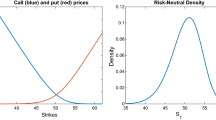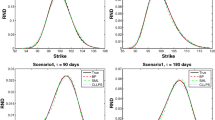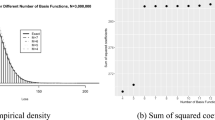Abstract
This paper presents a new formulation for conveniently extracting the risk-neutral density (RND) function from the scarce data of the call price quotes, in the absence of any standard functional form. The existing solutions require primarily estimating the call price function under no-arbitrage conditions and then estimating the RND function. In this exposition, an independent relation is derived from the definition itself that connects RND to the call price function using tools like Laplace transform and Abel’s summation formula. This transforms the situation into a regression problem with simple constraints. The resulting linearly constrained least-square minimization problem gives an exact solution for the decision vector. The efficacy and accuracy of the proposed method are tested and validated on S &P 500 option price data.










Similar content being viewed by others
Data availability statement
Data derived from public domain resources.
References
Aıt-Sahalia Y, Duarte J (2003) Nonparametric option pricing under shape restrictions. J Econom 116(1–2):9–47. https://doi.org/10.1016/S0304-4076(03)00102-7
Aït-Sahalia Y, Lo AW (1998) Nonparametric estimation of state-price densities implicit in financial asset prices. J Finance 53(2):499–547. https://doi.org/10.1111/0022-1082.215228
Aparicio S, Hodges S (1998) Implied risk-neutral distribution: a comparison of estimation methods. FORC preprint. University of Warwick, Coventry
Bǎnescu M, Popa D (2018) A multiple Abel summation formula and asymptotic evaluations for multiple sums. Int J Number Theory 14(04):1197–1210. https://doi.org/10.1142/s1793042118500732
Bates DS (1991) The crash of ’87: was it expected? the evidence from options markets. J Finance 46(3):1009–1044. https://doi.org/10.1111/j.1540-6261.1991.tb03775.x
Bates DS (2000) Post-’87 crash fears in the s &p 500 futures option market. J Econom 94(1–2):181–238. https://doi.org/10.1016/S0304-4076(99)00021-4
Benko M, Fengler M, Härdle W, Kopa M (2007) On extracting information implied in options. Comput Stat 22(4):543–553. https://doi.org/10.1007/s00180-007-0061-0
Birke M, Pilz KF (2009) Nonparametric option pricing with no-arbitrage constraints. J Financ Econom 7(2):53–76. https://doi.org/10.1093/jjfinec/nbn016
Black F, Scholes M (1973) The pricing of options and corporate liabilities. J Polit Econ 81(3):637–654
Bliss RR, Panigirtzoglou N (2002) Testing the stability of implied probability density functions. J Bank Finance 26(2–3):381–422. https://doi.org/10.1016/S0378-4266(01)00227-8
Bondarenko O (2003) Estimation of risk-neutral densities using positive convolution approximation. J Econom 116(1–2):85–112. https://doi.org/10.1016/S0304-4076(03)00104-0
Breeden DT, Litzenberger RH (1978) Prices of state-contingent claims implicit in option prices. J Bus 51(4):621–651. http://www.jstor.org/stable/2352653
Brezinski C, Redivo-Zaglia M, Rodriguez G, Seatzu S (2003) Multi-parameter regularization techniques for ill-conditioned linear systems. Numer Math 94(2):203–228. https://doi.org/10.1007/s00211-002-0435-8
Brunner B, Hafner R (2003) Arbitrage-free estimation of the risk-neutral density from the implied volatility smile. J Comput Finance 7(1):75–106
Campa JM, Chang PK, Reider RL (1998) Implied exchange rate distributions: evidence from OTC option markets. J Int Money Finance 17(1):117–160. https://doi.org/10.1016/S0261-5606(97)00054-5
Chu W (2007) Abel’s lemma on summation by parts and basic hypergeometric series. Adv Appl Math 39(4):490–514. https://doi.org/10.1016/j.aam.2007.02.001
Fan J, Mancini L (2009) Option pricing with model-guided nonparametric methods. J Am Stat Assoc 104(488):1351–1372. https://doi.org/10.1198/jasa.2009.ap08171
Fengler MR (2009) Arbitrage-free smoothing of the implied volatility surface. Quant Finance 9(4):417–428. https://doi.org/10.1080/14697680802595585
Fengler MR, Hin LY (2015) Semi-nonparametric estimation of the call-option price surface under strike and time-to-expiry no-arbitrage constraints. J Econom 184(2):242–261. https://doi.org/10.1016/j.jeconom.2014.09.003
Healy JV, Dixon M, Read BJ, Cai FF (2007) Non-parametric extraction of implied asset price distributions. Physica A 382(1):121–128. https://doi.org/10.1016/j.physa.2007.02.013
Heston SL (1993) A closed-form solution for options with stochastic volatility with applications to bond and currency options. Rev Financ Stud 6(2):327–343. https://doi.org/10.1093/rfs/6.2.327
Kahalé N (2004) An arbitrage-free interpolation of volatilities. Risk 17(5):102–106
Kundu A, Kumar S, Tomar NK, Gupta SK (2016) Call option price function in Bernstein polynomial basis with no-arbitrage inequality constraints. J Inequal Appl 2016(1):1–16. https://doi.org/10.1186/s13660-016-1097-x
Kundu A, Kumar S, Tomar NK (2019) Option implied risk-neutral density estimation: a robust and flexible method. Comput Econ 54(2):705–728. https://doi.org/10.1007/s10614-018-9846-1
Laurini MP (2011) Imposing no-arbitrage conditions in implied volatilities using constrained smoothing splines. Appl Stoch Model Bus Ind 27(6):649–659. https://doi.org/10.1002/asmb.877
Malz AM (1997) Estimating the probability distribution of the future exchange rate from option prices. J Deriv 5(2):18–36
Melick WR, Thomas CP (1997) Recovering an asset’s implied pdf from option prices: an application to crude oil during the gulf crisis. J Financ Quant Anal 32(1):91–115. https://doi.org/10.2307/2331318
Monteiro AM, Tütüncü RH, Vicente LN (2008) Recovering risk-neutral probability density functions from options prices using cubic splines and ensuring nonnegativity. Eur J Oper Res 187(2):525–542. https://doi.org/10.1016/j.ejor.2007.02.041
Orosi G (2012) Empirical performance of a spline-based implied volatility surface. J Deriv Hedge Funds 18(4):361–376. https://doi.org/10.1057/jdhf.2012.1
Orosi G (2015) Arbitrage-free call option surface construction using regression splines. Appl Stoch Model Bus Ind 31(4):515–527. https://doi.org/10.1002/asmb.2045
Ritchey RJ (1990) Call option valuation for discrete normal mixtures. J Financ Res 13(4):285–296. https://doi.org/10.1111/j.1475-6803.1990.tb00633.x
Rookley C (1997) Fully exploiting the information content of intra day option quotes: applications in option pricing and risk management. University of Arizona, Tucson
Yatchew A, Härdle W (2006) Nonparametric state price density estimation using constrained least squares and the bootstrap. J Econom 133(2):579–599. https://doi.org/10.1016/j.jeconom.2005.06.031
Acknowledgements
The authors are grateful to the anonymous reviewers and editor(s) for the constructive comments and suggesting necessary changes which led to the improvement of this manuscript.
Author information
Authors and Affiliations
Corresponding author
Ethics declarations
Conflict of interest
The authors have no conflict of interest.
Additional information
Communicated by Silvana Manuela Pesenti.
Publisher's Note
Springer Nature remains neutral with regard to jurisdictional claims in published maps and institutional affiliations.
A Preliminaries
A Preliminaries
Laplace transform. The Laplace transform of a function f(K), defined for all \(K \ge 0\), is the function \(F(\omega )\), which is a unilateral transform defined by
where \(\omega \) is the transformation parameter. A necessary condition for existence of the integral is that f must be locally integrable on \([0,\infty )\). For locally integrable functions that decay at infinity or are of exponential order \(|f(t)|\le A e^{B|t|}\), the integral can be understood as a proper Lebesgue integral. The notation is \({\mathcal {L}}_{K}[.](\omega )\) which is read as the Laplace transform of a function from variable K to variable \(\omega \).
Final value theorem. In the theory of Laplace transform, the final value theorem (FVT) states that if both f(t) and \(f'(t)\) have Laplace transforms that exist, then
where \(F(\omega )\) is the Laplace transform of f(K).
Abel summation formula. Let \(A(t) = \sum _{0\le n\le t} a_{n}\) be the partial sum of a real-valued sequence \((a_{n})_{n=0}^{\infty }\), then for a continuously differentiable function \(\phi (t)\) on \([0,\infty ]\), we have
Abel’s summation formula, one gets an integral representation for a summation and vice versa. Using Abel’s summation formula can be generalized to the case where \(\phi \) is only assumed to be continuous if the integral is interpreted as a Riemann–Stieltjes integral:
The discussion on the formula can be found in several sources, for instance, Chu (2007); Bǎnescu and Popa (2018).
Summation-by-parts. For \((f_k)_{0\le k\le n}\) and \((g_k)_{0\le k\le n}\), we have
for \(n \in {\mathbb {N}}_0\).
First mean value theorem for integrals. Let \(f: [a,b] \rightarrow {\mathbb {R}}\) be a continuous function, then there exists a constant \(c \in (a,b)\) such that
The value f(c) can be essentially understood as the value of the function f(x) within a small interval [a, b].
Rights and permissions
Springer Nature or its licensor (e.g. a society or other partner) holds exclusive rights to this article under a publishing agreement with the author(s) or other rightsholder(s); author self-archiving of the accepted manuscript version of this article is solely governed by the terms of such publishing agreement and applicable law.
About this article
Cite this article
Kumar, A., Kumar, S. Novel computational technique for the direct estimation of risk-neutral density using call price data quotes. Comp. Appl. Math. 42, 270 (2023). https://doi.org/10.1007/s40314-023-02395-7
Received:
Revised:
Accepted:
Published:
DOI: https://doi.org/10.1007/s40314-023-02395-7




